My Dog is Limping Causes and Solutions
Understanding and Addressing the Causes of Your Dog’s Limping

Seeing your dog limp can be an alarming experience, filled with worry and uncertainty. You might find yourself asking, “What could be wrong?” and “How can I help?” Limping in dogs is a common concern that many pet owners face, and it can stem from a variety of causes, ranging from minor injuries to more serious health conditions. This article aims to demystify the reasons behind your dog’s limp and provide you with practical solutions to ensure your furry friend gets back to their playful self as quickly as possible.
Imagine the joy of a carefree walk in the park with your dog, only to notice a sudden change in their gait. That unexpected limp can transform a pleasant outing into a moment of concern. Understanding the potential causes of limping and knowing the immediate steps to take can make a significant difference in your pet’s recovery. Whether you’re a new dog owner or have years of experience, it’s crucial to be equipped with the right knowledge to address this common issue effectively.
Limping can result from a variety of factors, including injuries, infections, or chronic conditions. Recognizing the signs early and taking appropriate action can help prevent further complications. In this article, we’ll explore the most common causes of limping in dogs, from minor scrapes and bruises to more serious conditions like arthritis or hip dysplasia. We’ll also provide you with practical home remedies for minor injuries and discuss long-term care strategies to keep your dog healthy and active.
Your dog’s well-being is a top priority, and being proactive about their health can ensure they lead a happy, pain-free life. By the end of this article, you’ll have a comprehensive understanding of what might be causing your dog’s limp and the best ways to help them recover. So, let’s dive in and learn how to keep your four-legged friend on all fours!
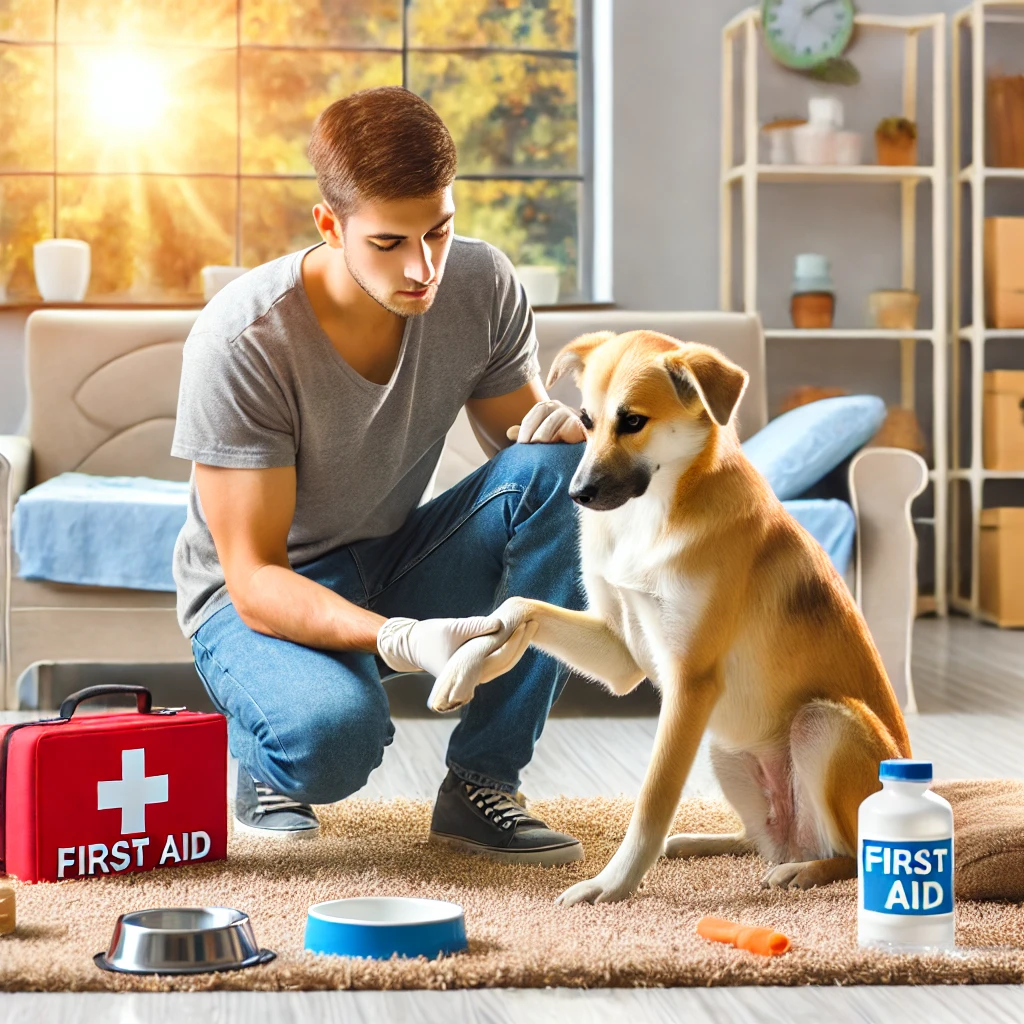
How to Treat a Limping Dog at Home
Caring for your dog at home can be an act of love and comfort. Here’s a simple, step-by-step guide:
Rest & Restricted Movement
Encourage calm and limit jumping, running, or long walks for at least 3–5 days. Use a cozy crate or a quiet room if needed.Gentle Ice or Warm Compresses
• For swelling or sprains: apply a wrapped ice pack for 10 minutes, 3 times daily.
• For stiffness (like arthritis): use a warm towel for 10 minutes, once or twice daily.Check the Injured Limb
• Sprain: slight swelling, tender to touch, dog still tries to walk.
• Dislocation: obvious misalignment, limb looks “dangling,” and your dog has sudden trouble standing and walking.Observe Behavior & Comfort
Is your dog limping but not in pain? Are they still eager to eat, wag their tail, or play a little? These are hopeful signs.When to See a Vet
• Limping continues past day 5 despite care.
• Limb appears deformed, very swollen, or is cold to the touch.
• Your dog yelps or refuses to move.Loving them through recovery means trusting your instincts—and knowing when expert help is best.
Immediate Steps to Take When Your Dog is Limping
When you notice your dog limping, it’s natural to feel a surge of concern. Your immediate actions can significantly impact your dog’s comfort and recovery. Here are the crucial steps to take when you first observe your dog limping.
Checking for Injuries
The first thing you should do is carefully examine your dog’s legs and paws for any visible signs of injury. Look for cuts, swelling, or bruising that might indicate trauma. It’s also essential to check for foreign objects like splinters, thorns, or glass that might be lodged in their paws. These objects can cause pain and infection if not promptly removed. Gently palpate the limb, feeling for any areas of tenderness or pain. This can help you identify whether the issue might be more serious, such as a sprain or fracture.
When to Seek Veterinary Care
Knowing when to seek veterinary care is critical. If your dog is in severe pain or unable to bear weight on the affected leg, you should seek veterinary care immediately. This is particularly important if the limping is accompanied by other symptoms like fever, lethargy, or loss of appetite, as these could indicate a more serious underlying condition. Persistent limping that lasts more than 24 hours should also be evaluated by a vet to rule out chronic conditions or more significant injuries. Your vet can perform a thorough examination and may recommend imaging tests like X-rays to diagnose the issue accurately.
By following these steps, you can ensure that you address the problem promptly and effectively, giving your dog the best chance at a quick and full recovery. Taking immediate action not only alleviates your dog’s pain but also prevents further complications down the line.
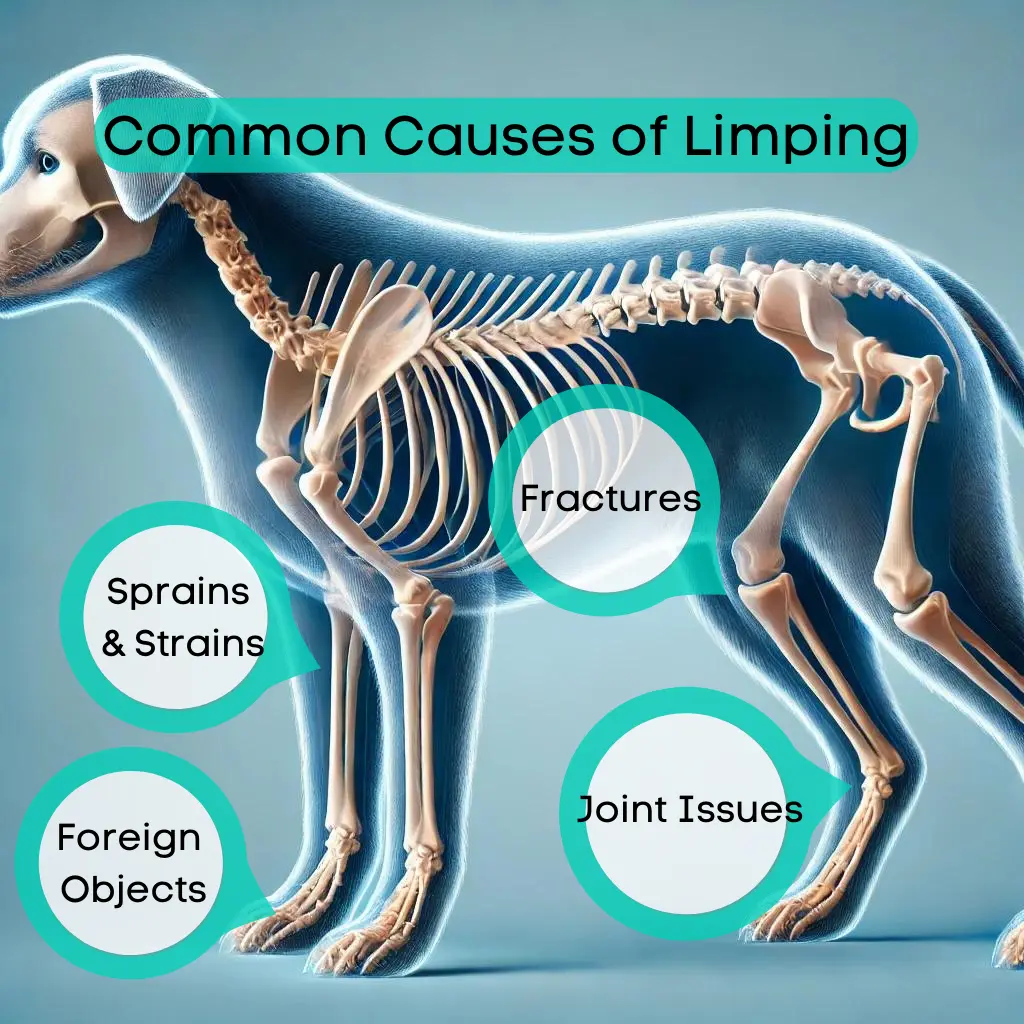
Common Causes of Limping
Understanding why your dog is limping is the first step in addressing the problem. There are several common causes of limping in dogs, each with distinct symptoms and treatment approaches. Let’s explore some of these causes to help you identify the potential issue and take appropriate action.
Sprains and Strains
Overexertion during play or exercise can often lead to sprained ligaments or strained muscles in dogs. These injuries are typically the result of sudden, excessive movement that the dog’s body isn’t accustomed to. Symptoms of sprains and strains include swelling, pain, and difficulty moving the affected limb. You might notice your dog favoring one leg, being hesitant to jump or climb stairs, or exhibiting signs of discomfort when the affected area is touched.
Fractures
Fractures can occur from trauma such as falls, accidents, or even rough play. This type of injury is usually more severe and can be quite painful for your dog. Signs of a fracture include intense pain, abnormal limb positioning, and an inability to use the limb. If you suspect your dog has a fracture, it’s crucial to immobilize the affected area and seek veterinary care immediately. Fractures often require professional treatment, including splints, casts, or even surgery, depending on the severity.
Joint Issues (Arthritis, Dysplasia)
Joint issues are a common cause of chronic limping in dogs, especially as they age. Arthritis is prevalent in older dogs and results in chronic pain and stiffness due to the inflammation of the joints. Hip and elbow dysplasia are genetic conditions that can affect dogs of all ages, leading to joint instability and pain. Symptoms of these conditions include limping, decreased activity, difficulty rising, and a reluctance to climb stairs or jump. Managing these conditions often involves a combination of weight management, physical therapy, and medications to reduce pain and inflammation.
Foreign Objects (Splinters, Thorns)
Sometimes, the cause of your dog’s limp can be as simple as a foreign object lodged in their paw pad. Splinters, thorns, or small pieces of glass can become embedded in your dog’s paw, causing significant pain and discomfort. Signs that your dog may have a foreign object in their paw include excessive licking, chewing at the paw, and limping focused on a specific leg. Carefully examining your dog’s paws and removing any visible objects can often resolve the issue. If the object is deeply embedded or if the area becomes infected, a visit to the vet may be necessary.
By recognizing these common causes of limping, you can better understand what might be affecting your dog and take the necessary steps to ensure their swift recovery. In the next section, we’ll discuss home remedies for minor injuries that can help alleviate your dog’s discomfort.
How to Treat a Limping Dog at Home
Caring for your dog at home can be one of the kindest ways to support their healing. Here’s a clear, compassionate guide:
1. Rest & Restricted Movement
– Encourage calm and limit jumping, running, or long walks for **3–5 days**.
– Use a cozy crate, gated-off area, or quiet room to help them stay sedentary.
2. Gentle Ice or Warm Compresses
– For swelling or sprains: apply a wrapped ice pack for **10 minutes**, 3 times daily.
– For stiffness (arthritis or muscle tightness): use a warm towel for **10 minutes**, once or twice daily.
3. Check the Injured Limb
– Sprained leg: slight swelling, tender to touch, but your dog still tries to walk.
– Dislocated leg: sudden trouble standing or walking, obvious misalignment, limb may look “dangling.”
4. Observe Behavior & Comfort
– If your dog is **limping but not in pain**, still eating, wagging their tail, or playing a little—it’s a hopeful sign.
5. When to See a Vet
– Limping continues past day 5 despite at-home care.
– Limb appears deformed, very swollen, or is cold to the touch.
– Your dog yelps, refuses to move, or has sudden onset trouble standing.
Condition-Specific Guidance
Dog Sprained Leg
A dog sprained leg occurs when muscles or ligaments stretch or tear. You might notice mild swelling, and your pup still tries walking. Treat with **rest, ice**, and gentle support for **3–5 days**, monitoring for worsening symptoms.
Dislocated Dog Leg
A dislocated dog leg is more severe and often sudden. The joint may look “out of place,” and your dog may have **sudden trouble standing and walking all of a sudden**. Seek immediate veterinary care to realign the joint and manage pain.
Dog Limping After Laying Down
Notice your dog limping after laying down? This can stem from stiffness or early arthritis. Try a gentle warm compress before activity and short, frequent walks to ease stiffness. If the limp persists, mention it during your next vet visit.
Dog Limping but Not in Pain
If your dog is limping but not in pain, still eating, wagging their tail, or playing, this may signal a mild sprain, paw irritation, or early joint signs. Continue home care, but stay alert. If it continues beyond a few days, book a checkup.
Dog Randomly Limping / My Dog Limps Sometimes
Does your dog randomly limp or limp sometimes? This could be due to minor strains, muscle fatigue, or foreign bodies like grass awns. Often it resolves quickly, but if it recurs or worsens, consult your vet for a thorough check.

Home Remedies for Minor Injuries
When your dog experiences a minor injury, there are several home remedies you can use to help them recover quickly and comfortably. These simple measures can make a big difference in reducing pain and swelling and promoting healing.
Cold Compress
A cold compress is an effective way to reduce swelling and numb pain in your dog’s injured limb. To apply a cold compress, wrap an ice pack or a bag of frozen peas in a cloth and place it on the affected area for 10-15 minutes. This should be done 2-3 times a day for the first 48 hours following the injury. The cold helps to constrict blood vessels, reducing inflammation and providing pain relief. Always ensure the cold pack is wrapped in a cloth to prevent frostbite and make the experience more comfortable for your dog.
Rest and Restricted Movement
Limiting your dog’s activity is crucial to prevent further injury and allow healing. Encourage your dog to rest by keeping them in a confined space or using a crate. This restriction helps to minimize movement and stress on the injured area. Avoid activities that could exacerbate the injury, such as running, jumping, or climbing stairs. Providing a comfortable, quiet space for your dog to rest can aid significantly in their recovery process.
Over-the-Counter Anti-Inflammatories (With Vet Approval)
Anti-inflammatory medications can be helpful in managing pain and reducing inflammation, but they should only be used under the guidance of a veterinarian. While medications like aspirin or ibuprofen might be prescribed for dogs, it’s important to never give your dog human medications without vet approval, as some can be toxic. Your vet can recommend the appropriate type and dosage of medication for your dog’s specific condition. Always follow your vet’s instructions carefully to ensure your dog’s safety and well-being.
By implementing these home remedies, you can effectively manage minor injuries and help your dog recover swiftly. However, if your dog’s condition does not improve or if you notice any signs of a more serious problem, be sure to consult your veterinarian for further guidance.
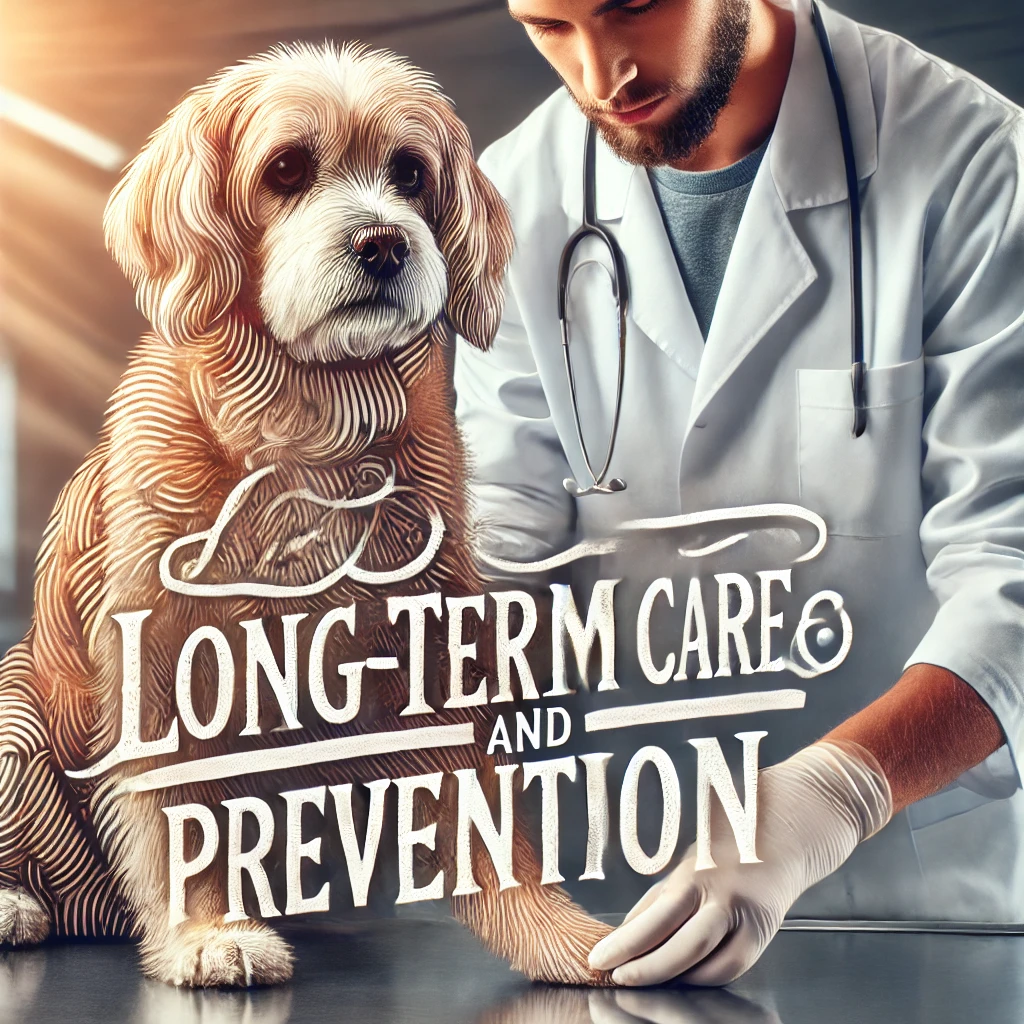
Long-Term Care and Prevention
Ensuring your dog’s long-term health and preventing future limping involves a proactive approach to their care. By incorporating regular check-ups, maintaining a healthy weight, and tailoring exercise routines, you can help keep your dog in optimal condition and minimize the risk of injuries.
Regular Check-Ups
Routine veterinary visits are essential for monitoring your dog’s overall health and catching potential issues early. Regular check-ups allow your vet to assess your dog’s physical condition, identify any emerging health problems, and provide timely interventions. These visits are particularly important for detecting conditions like arthritis or dysplasia early on, which can be managed more effectively when caught in the initial stages. Schedule these visits at least once a year, or more frequently if your dog has existing health concerns.
Maintaining a Healthy Weight
Maintaining a healthy weight is crucial for reducing stress on your dog’s joints and limbs. Excess weight can exacerbate conditions like arthritis and increase the risk of injury. Ensure your dog is fed a balanced diet and provide appropriate portion sizes to prevent overeating. Consult your vet to determine the ideal weight range for your dog’s breed and size, and adjust their diet accordingly. Regularly monitoring your dog’s weight and body condition can help you make necessary dietary adjustments to maintain their health.
Appropriate Exercise Routines
Providing regular exercise tailored to your dog’s age, breed, and physical condition is vital for their overall health and well-being. Regular physical activity helps maintain muscle strength, joint flexibility, and a healthy weight. For dogs with joint issues or those prone to injuries, incorporating low-impact activities like swimming can be beneficial. Swimming provides excellent exercise without putting stress on the joints. Avoid overexertion by gradually increasing the intensity and duration of exercise, and always be mindful of your dog’s limits. Regular, moderate exercise is more beneficial than sporadic intense activity.
By implementing these long-term care and prevention strategies, you can help your dog stay healthy, active, and less prone to injuries. Taking a proactive approach to your dog’s health ensures they enjoy a happy, pain-free life.

Conclusion of My Dog is Limping Causes and Solutions
Your loving attention and timely care can transform a limp into a happy gait.
By learning the possible causes—sprains, strains, dislocations, stiffness, or simple foreign irritants—you’re taking powerful strides for your dog’s well-being. Through thoughtful home remedies, regular monitoring, and knowing when to seek veterinary care, you’re not just easing discomfort—you’re strengthening the bond and trust you share.
Thank you for taking the time to read this article: My Dog is Limping Causes and Solutions
Your dedication to your dog’s well-being is commendable, and with the right knowledge and tools, you can provide the best care for your furry friend. Together, let’s ensure our dogs lead long, healthy, and joyful lives.

People Also Ask
Q: What should I do if my dog is limping?
A: If your dog is limping, first check for any visible injuries or foreign objects in their paws. Gently palpate the limb to identify any tender areas. Apply a cold compress to reduce swelling and ensure your dog rests. If the limping persists for more than 24 hours, seek veterinary care to rule out serious conditions.
Q: How can I tell if my dog’s limp is serious?
A: Signs that a limp is serious include severe pain, inability to bear weight on the limb, visible deformities, and symptoms like fever, lethargy, or loss of appetite. If you notice any of these signs, it is important to consult a veterinarian immediately.
Q: Can I give my dog human pain relievers for limping?
A: You should never give your dog human pain relievers like aspirin or ibuprofen without veterinary approval, as some medications can be toxic to dogs. Always consult your vet for appropriate medication and dosage.
Q: What are the common causes of limping in dogs?
A: Common causes of limping in dogs include sprains, strains, fractures, arthritis, hip or elbow dysplasia, and foreign objects lodged in the paw. Each cause requires different treatment, so proper diagnosis is crucial.
Q: How can I prevent my dog from limping?
A: To prevent limping, ensure your dog maintains a healthy weight, provide regular exercise tailored to their needs, and schedule routine veterinary check-ups. Avoid overexertion and include low-impact activities like swimming for dogs with joint issues.
Q: When should I take my dog to the vet for limping?
A: You should take your dog to the vet if the limping is severe, lasts more than 24 hours or is accompanied by other symptoms such as fever, lethargy, or loss of appetite. Immediate veterinary care is needed for intense pain or visible limb deformities.
Q: Why do dogs limp?
A: Limping can be caused by strains, sprains, arthritis, wounds, soft-tissue injuries, or dislocations. Each has its own signs and treatments.
Q: What if my dog is limping but not in pain?
A: Minor sprains or early arthritis can explain painless limping. Manage at home and observe; consult your vet if it recurs.
Q: How do I treat a sprained leg at home?
A: Rest, ice wrapped in a towel for 10 minutes thrice daily, restricted movement, and gentle activity begin after a few days of rest.
Q: What does a dislocated dog leg look like?
A: Look for a limb that appears out of joint, is floppy or angled, heat, swelling, and sudden refusal to walk. This needs urgent vet care.
Q: My dog limps sometimes—is this okay?
A: Occasional limps are common and usually harmless, but if they repeat or worsen, consult your vet for a proper exam.
References
This article is informed by a range of reputable sources, each offering valuable insights into the causes, immediate steps, home remedies, and long-term care related to dog limping.
The American Kennel Club provides a comprehensive guide on why dogs may limp, highlighting various potential causes and initial steps for owners to take (source). VCA Animal Hospitals offers detailed information on recognizing and addressing limping in dogs, emphasizing the importance of veterinary care for persistent or severe cases (source).
PetMD discusses the symptoms and treatment options for dog limping, focusing on understanding the underlying causes to provide appropriate care . The Spruce Pets offers practical advice on what to do when your dog is limping, including home remedies and when to seek veterinary help.
The ASPCA outlines common causes of limping in dogs and provides guidance on prevention and care. Canna-Pet discusses various causes, symptoms, and treatments for dog limping, including the use of natural remedies.
WebMD and Fetch by WebMD both offer extensive information on the causes and treatments of dog limping, with practical advice on immediate steps and long-term care (source, source). Vetstreet provides expert insights into common causes and treatments for dog limping, helping owners to identify and address various issues (source). Lastly, Blue Cross for Pets offers guidance on managing lameness in dogs, with a focus on both immediate and preventive care.
- American Kennel Club. (n.d.). Why is My Dog Limping? Retrieved from https://www.akc.org/expert-advice/health/why-is-my-dog-limping/
- VCA Animal Hospitals. (n.d.). Limping in Dogs. Retrieved from https://vcahospitals.com/know-your-pet/limping-in-dogs
- PetMD. (n.d.). Dog Limping and Pain. Retrieved from https://www.petmd.com/dog/symptoms/why-is-my-dog-limping
- The Spruce Pets. (2023). Why Is My Dog Limping?. Retrieved from https://www.thesprucepets.com/why-is-my-dog-limping-4125207
- ASPCA. (n.d.). Signs a Dog Is In Pain. Retrieved from https://www.aspcapetinsurance.com/resources/detecting-and-managing-pain-in-dogs/
- Canna-Pet. (2018). Limping in Dogs: Causes, Symptoms, and Treatment. Retrieved from https://canna-pet.com/articles/limping-in-dogs/
- WebMD. (n.d.). What to Do If Your Dog Is Limping. Retrieved from https://pets.webmd.com/dogs/what-to-do-if-your-dog-is-limping
- Fetch by WebMD. (n.d.). Limping in Dogs: Causes and Treatments. Retrieved from https://pets.webmd.com/dogs/limping-in-dogs-causes-and-treatments
- Vetstreet. (n.d.). Why is My Dog Limping? Common Causes and Treatments for Limping in Dogs. Retrieved from http://www.vetstreet.com/our-pet-experts/why-is-my-dog-limping-common-causes-and-treatments-for-limping-in-dogs
- Blue Cross for Pets. (n.d.). What are the signs and symptoms of arthritis in dogs? Retrieved from https://www.bluecross.org.uk/advice/dog/health-and-injuries/arthritis-in-dogs
These references provide valuable information on the causes, immediate steps, home remedies, and long-term care related to dog limping. They are essential for anyone seeking to understand and address this common issue in dogs.







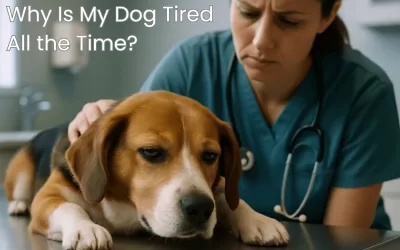
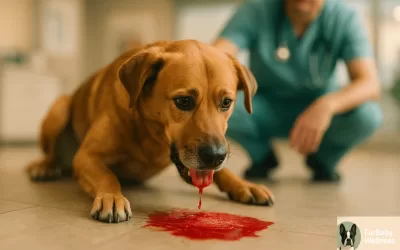







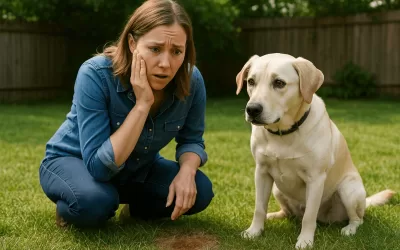









0 Comments